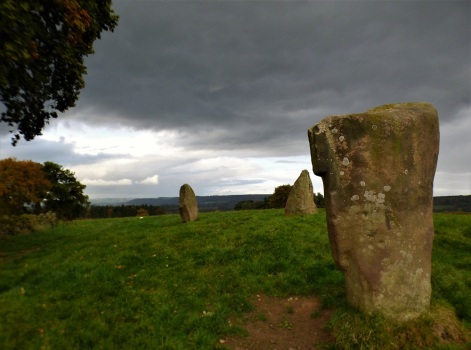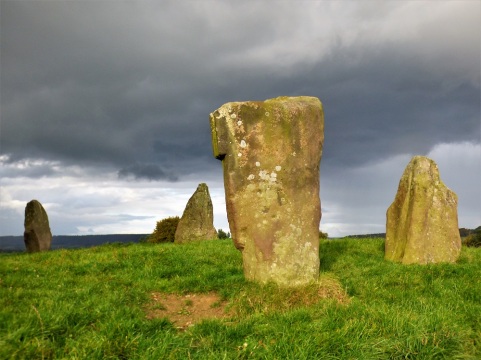Continuing the story of a Silent Eye workshop in Derbyshire, in December 2017. Parts One, Two, Three, Four, Five, Six, Seven, Eight and Nine can be found by clicking the highlighted links.

A labyrinthine path leads to a summit that ends abruptly in a sheer and unforgiving cliff. From this side, the settlement on Cratcliffe Tor would have been impregnable. Yet, there seems little space or evidence for a group of homes in this place. There are other sites nearby where ancient settlements have been found and, although Cratcliffe, Robin Hood’s Stride and the stone circle below them may have been at the heart of a community, we do not think it was here that they lived. They were important for another reason. The rocks, the confusing pathway and uneven landscape seem rather to lend themselves to a minimal population and reminds me of other sites that we suspect may have been ritual landscapes, places where the births and deaths of a clan would have been marked. Certainly the summit, with its great beds of stone, would have been a perfect place for air burial.

One stone bed in particular seems designed for this purpose. A low, pillowed couch that slopes down to a trough… that got me into trouble when I suggested it could have been ‘for the juices’. For some reason, the phrase did not go down well with my companions.

This is not pure speculation. We know that air burial was an efficient way to clean the bones of the dead and it would seem that our forefathers held a belief that the process of dying was not complete until the bones were clean. We know, from archaeological evidence, that many different methods were used to hasten this process. Perhaps the dead could not become ancestors, guarding and promoting the wellbeing of the clan in the otherworld, until their bones were properly prepared.

The presence of a stone circle and other ritual sites close by would suggest that this was a place where the human journey, from birth into death, and from death into the otherworld was ritually marked. One of our companions felt strongly that a tranquil glade had been a place where the healers worked. At another spot, where a stark cut in the high cliffs drops to the valley below, has a ‘feel’ of a place of judgment, where one guilty of the most heinous crimes against his people would be cast down the sheer drop to his death. Dowsing seemed to confirm this.

Much of what we suspect about the way in which these sites were used in prehistoric times cannot be substantiated by any means that the scientific mind would accept, but in many ways, this does not matter. It is alternative archaeology. When the land whispers stories to the inner ear, there is no way of knowing whether what we hear is fact or fiction. What we do know is that such promptings make sense of the landscape, bring it to life for us, and allow us to see it with a new understanding, possibly one that brings us closer to the vision of our most distant ancestors.

On the plain below, forming a triangle with the Tor and the Stride, is a stone circle known as Nine Stones Close. Only four of these stones now remain… ‘squaring the circle’… though at least one other remains close by, reused in a stone wall. The circle used to be called the Grey Ladies and legends told of maidens who danced on the sabbath and were turned to stone for their impiety. I wonder if the story originated with the hermit of the crag, for certainly it is a Christian gloss on the story of the stones.

Another story tells of a farmhand who, resting from his labours against one of the stones, found a pipe. Lighting the pipe, he watched as the stones became transparent and through their surface he could see into the fairy realms. This tale may have its origins in an older memory, perhaps, of a time when sacred herbs were used to enhance vision and allow the priesthood of the stones a glimpse into the otherworld.

The Bronze Age circle would have been over forty feet in diameter, with the stones standing over seven feet tall. It is from the centre of this circle that the major southern moon can be observed between the pinnacles of the Stride. The stones are the tallest standing stones of any circle in Derbyshire… but our next visit would take us to a place where these stones would be dwarfed. As the light faded, we left the fields and headed for the warmth of an old inn to await the coming of darkness…










































Test Comment
LikeLike
This seems like a unique landscape, different from many shared in your photos, Sue. The stone and stone formations are impressive. I love the idea of alternate archeology (intuitive archaeology). Mesmerizing post.
LikeLike
The stones here seem to gather so many facets of the landscape in one place… and still manage to look both ‘normal’ for the area..and indeed, quite unique.
LikeLiked by 1 person
Reblogged this on France & Vincent.
LikeLiked by 1 person
I would love to touch some of those stones…
LikeLike
I know, Jaye… x
LikeLike